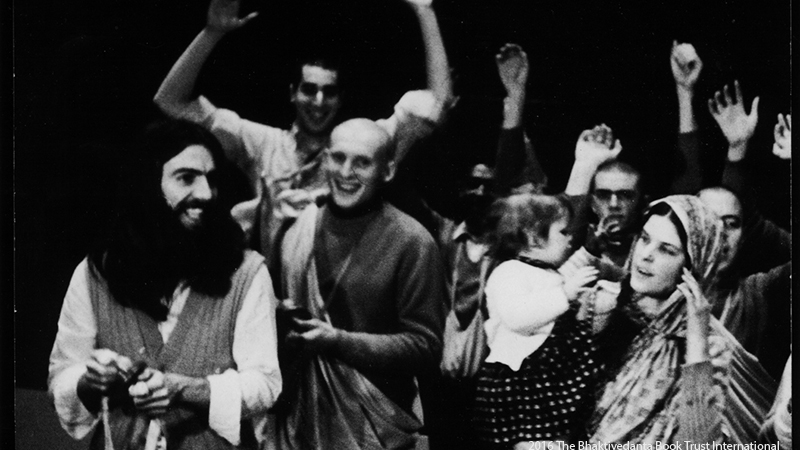Learn how George Harrison brought bhakti yoga to the West with the now ubiquitous Hare Krishna mantra.
George Harrison was born in Liverpool in 1943. He began playing guitar at age twelve, and by the time he was seventeen, he was a Beatle, one of four musicians who permanently changed the landscape of popular music history. By the time he was 25and committed to spiritual pursuits, Harrison was to pop music what Picasso was to art or Thomas Edison to: an astounding talent, an important example of what an innovative mind could bring to his craft. A generation raised in the turmoil of war and hungering for a more enlightened way to live appreciated not only his music but his thinking. What he did—both as a Beatle and as an independent singer-songwriter after the group’s dissolution—got people excited.
At a Christmas reception at Apple Studios, the Beatles were holding a press conference about their upcoming Abbey Road album. John peeked out from the pressroom, scanned the crowd assembled for the reception, and made a quick exit out of the building. Ringo peeked out and did the same, followed by Paul. George peeked out, looked around the room, and spied the shaven-headed Shyamsundar, one of Swami Prabhupada’s main disciples. George had seen a photo of him with the other devotees in a Times of London article titled “Krishna Chant Startles London.” The article reported on the devotees’ arrival in England and their plans for opening a temple. George walked over and said, “Where have you been? I’ve been waiting to meet you.”
And so began a friendship that led to an invitation for Shyamsundar to live with George at his manor home and an invitation for devotees to record the Hare Krishna mantra on the Apple Records label. “I can see it now,” Harrison told them. “The first Sanskrit tune in the top ten.”
In April 1969, the devotees arrived at Abbey Road Studios. Guards escorted them into a large, soundproof room filled with equipment. Paul and Linda McCartney waved from behind a glass control booth. Mukunda, who had been a jazz pianist before joining Krishna consciousness, took his place behind a grand piano, and George worked with him on a melody line. Technicians positioned microphones around the room. One take, two takes—then on the third try the maha-mantra flowed: “Hare Krishna, Hare Krishna . . .” Yamuna’s strong voice led the chorus, commanding and pure, slightly nasal as Indian singing often tended to be. The music swelled, gained momentum, and spiraled for three-and-a-half minutes of pure transcendental sound, until—Bonnng! Malati hit a gong and brought the show to a spontaneous and rousing end. George and Paul went back to finishing work on the Abbey Road album, while the devotees crowded into their tiny van and drove off wondering what would become of the recording.
Listen to George Harrison’s Hare Krishna recording
In August 1969, “Hare Krishna Mantra” was released and received favorable reviews in the British papers and constant airplay on U.K. radio. On the first day of its release, the record sold 70,000 copies and entered the charts at number 20. Within two weeks, it rose to the number twelve spot, selling 20,000 copies a week in London alone. England’s most popular television show, Top Of The Pops, twice broadcast devotees chanting Hare Krishna surrounded by go-go dancers and swirling clouds of dry-ice mist. George watched the nationally televised show with glee. It was, he later remarked, “one of the greatest thrills in my life.”
The Apple Studios recording of the “Hare Krishna Mantra” track climbed the charts in Holland, France, Germany, Czechoslovakia, Sweden, Australia, South Africa, and Japan. Devotees found themselves signing autographs and posing for photos wherever they went. George had his staff book the London devotees at outdoor rock concerts, on television shows, and in nightclubs across Europe. They traveled, sang with Joe Cocker, played with the band Deep Purple in Amsterdam and with The Moody Blues in Sheffield. They headlined at the Midnight Sun Festival in Stockholm and appeared at the Star Club in Hamburg, where the Beatles had begun their career. The phrase “Hare Krishna” earned constant airplay on radio and television. It poured out of speakers in clubs and restaurants and found its way into newspapers, magazines, movies, and comedy routines. Other bands incorporated the mantra into their records and concerts. Sometimes in earnest, sometimes in jest, the chanting of Hare Krishna spread around the world.
When The Beatles sang “All You Need Is Love” on a live satellite broadcast in June 1967, the worldwide transmission reached more than 500 million television viewers. Now, barely two years later, George Harrison was reaching an even larger audience with the Hare Krishna mantra, and in doing so he was helping to fulfill a prophecy dating from the sixteenth century.
“One day,” Chaitanya Mahaprabhu had predicted, “the chanting of the Holy Names of Krishna will be heard in every town and village of the world.”
And so they were.
From: Yoga Journal

